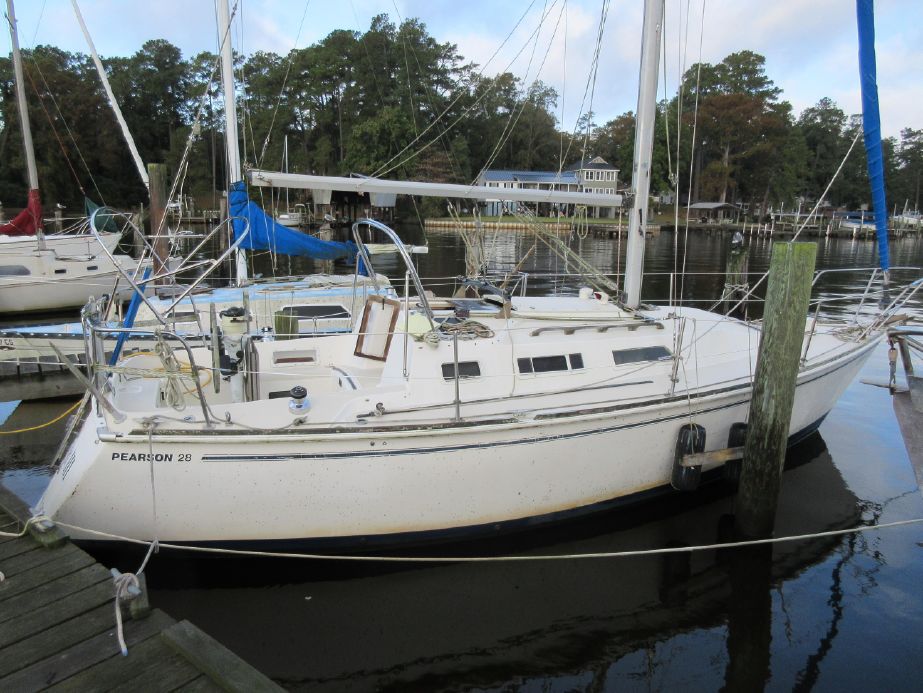A number of years ago we were planning our first Caribbean charter vacation, trying to decide what boat to choose for our week long trip. We had made any number of week long passages on our Alberg 30 over the years without feeling too cramped for space. To make a long story short, we decided on a J/28 and had a wonderful time. The size was all we needed, in fact, a fair bit more interior volume than our A-30 and, while we weren’t overwhelmed by the beauty and style of this modern design, we soon grew to appreciate some of the advantages offered by wider beam, higher freeboard and the generally stubbier look of more modern designs.
A few years later, when we found ourselves in the market for a replacement for the Alberg 30 we had sailed for nearly 10 years, we found we were spoiled by our Caribbean experience. We were now willing to compromise our preference for classic styling in favor of a little more interior volume, hot water, and a shower. Two other primary factors were our budget and the size of our slip. After all things were considered, we chose a Pearson 28 as a replacement for the classic 25 year old boat we had enjoyed so much but no longer had the time to maintain.
Pearson Yachts has a long history of building very successful boats in the 28’ size range dating back to the Pearson Triton, introduced in 1959. The period from 1975 to 1982 saw the first Pearson 28, which was patterned after Pearson’s hugely successful 26 and 30 foot models. The latest and last Pearson 28, and the subject of this review, was produced from 1985 through 1989.
Hull construction of a Pearson 28 is a solid laminate of fiberglass cloth and plastic resin. Decks utilize an end grain balsa core for added strength and rigidity. The deck and hull are joined with through bolts on an outward flange covered by a plastic molding. This method of joining the hull and deck has the disadvantage of being easily damaged by minor collisions with docks and pilings but is otherwise strong and secure. Construction is sound, and I have yet to find any serious delaminations or bonding failures. Some typical problem areas to keep an eye out for are persistent leaks around cabin windows and ports, broken plastic through hull fittings at the port and starboard deck scupper drains, and plastic rubrails cracked from impact with docks and pilings. It is also quite common to find a moderate amount of osmotic blistering if bottoms have not been barrier coated.
Auxiliary power is provided by a two cylinder 15 or 18 hp Yanmar diesel engine. P-28s were standardly-equipped with a fixed two blade propeller. This is plenty of power for this size boat under nearly all conditions. The layout of the Pearson 28 utilizes space well. There is a quarter berth cabin along the port side, a V-berth forward, and a U-shaped settee with a drop leaf table which forms a dinette forward in the saloon. There is a small galley along the port side and a good-sized ice box on the starboard side. The lid to the ice box makes for an adequately sized chart table. There is a fully enclosed head with an integral shower aft on the starboard side. Storage space under berth and seat cushions is adequate. If this sounds like a lot to pack into a 28’ boat, it is. The down-side of this interior is that this is not a boat designed with big people in mind. The longest berth is only slightly over 6’, and although the port side quarter berth is wide enough for two people, half the berth is tucked under the cockpit. Overhead clearance is insufficient for all but young children. Cabin doors provide privacy for the quarter berth cabin and head but are very narrow and sometimes difficult for a grown adult to get in and out of. Ventilation is about as good as it can get on a boat of this size. There are three deck hatches, although the foredeck hatch is the only one large enough for escape or to fit a sail bag through. In addition there are five opening ports.
One of the benefits of my job is that, over the years, I have been able to sail on literally hundreds of different boats. Of all these, there are only a few dozen models I have had a chance to sail for any period of time or under a variety of conditions, so when commenting on sailing qualities, I often rely on accounts of others. However, with the P-28, I can tell you first hand that under all the conditions I have encountered on the Bay, this is a very nice sailing boat. I have never been able to get the boat to point quite as high as I think she should. This is probably because our boat still has the original factory-supplied mainsail which, not to mince words, is terrible quality. No doubt the addition of a well-made mainsail would pick up a few degrees. I am most impressed with the way the boat balances under nearly all conditions. Even overpowered there is practically no weather helm.
Over the years we had become accustomed to unsolicited comments about the attractiveness of our Alberg 30. It is unlikely passersby will offer similar comments about her replacement, but this is a tough boat to beat in this size range for practicality, value, and sailing comfort. This was quite a popular boat in this area, and there always seem to be a few on the market.
As I’ve said before, all boats are compromises, and we have learned to appreciate our Pearson 28 for all its plusses. We’re very happy with our choice.





